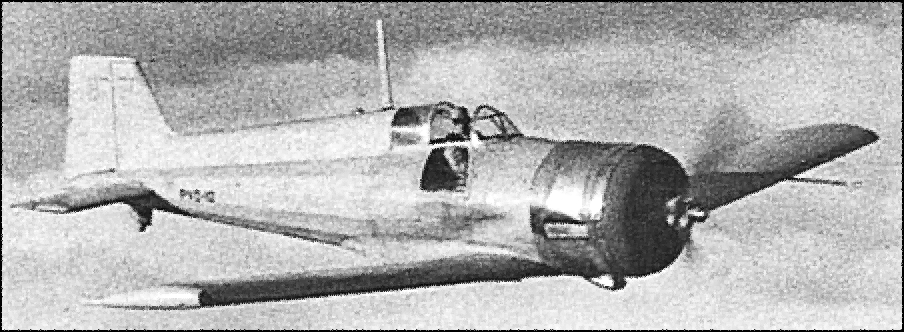What Could Have Been?
To recap, the goal here was to imagine how an early 1930's French prototype fighter - the Wibault 313 - might have evolved by 1940 *if* they had decided to peruse the idea. Here's a photo just to remind you what the aircraft looked like in it's original configuration...
Now, perhaps you can see from the above photo of the Wib. 313 prototype what I saw and that is the potential for this aircraft to have developed into a version which would have been typical of monoplane fighter configurations in the early part of World War 2. Notably the addition of an enclosed cockpit and a retractable undercarriage.
As it stood, the Wib. 313 - to me at least - looked like a sort of primordial P-47 Thunderbolt! And this is why I gave my 'what if?' aircraft design the name of 'Orage' - which is French for thunderstorm.
Intermission! A Divergence About Convergence.
You'll be used to me going off on tangents by now, and so... I alluded to the idea of design convergence in part 1 of this project - the idea that unconnected designers working to produce a design given to same criteria goals and same technological tool kit are likely to come up with similar solutions independently of each other. Just look at todays latest generation of stealthy fighters - they all look roughly similar (no, it's not everyone copying the F-35)!
So, it was interesting to compare my idea for my Wib 400 to other similar designs of the time - like the Fokker D. XXI, or the Brewster Buffalo, or the Republic Lancer, or the Curtis 75 - to show this kind of sort of general concurrence of technological innovation. But, looking at the original Wibault 313 design - the inspiration of this project and my idea - I di wonder just how close it was to getting to my Wib. 400 concept?
The main differences between the real Wibault [313] aircraft and my imaginary [400] progeny are the inclusion of the enclosed cockpit and the retractable undercarriage. And - still in the realms of the hypothetical - I did wonder just how far off these innovations might have been for a early 1930s aircraft design?
Well the first fighter aircraft to incorporate a folding and retractable undercarriage was the Grumman FF-1 of 1931, so not far off from the inception of the Wib. 313 then...BUT (there is always a but) in a janky 'one step forward but one step back' anomaly the Grumman fight was a biplane design!
And so... I did a little digging (with Google) and the first monoplane fighter that I could find was the Soviet Tupolev I-14 of 1933...AND - would you believe it - but just look at what this aircraft looks like...
Look familiar? 😉 I can't think of a better 'coincidence' to illustrate the concept of design convergence! Yes, there are slight differences and, yes, the Tupolev has an open cockpit, but it's pretty close to my Wib. 400 though. And I think it shows that the Wibault company were just a couple of steps behind in their innovations (I might even imagine a hypothetical and transitional Wib. '350' with either a enclosed cockpit but fixed undercarriage or vice versa)!
Meanwhile, Back at the Ranch...
Being Very Sketchy...
As it turned out, this project was a quicker job than I expected. I think it was because it was a fictional design so the amount of detail that I was able to reference was a bit thin on the ground (working, as I was, from one vague line-drawing and a couple of very blurry photos).
So, in the end, I completed the basic drawing of the aircraft with ease, but it's hardly a detailed or hyper-realistic profile...
 |
| Above: The basic aircraft drawing without any decoration. Although I used a light grey as a foundation colour this is not meant to represent a 'silver' bare metal plane. It's just a plain plane... |
I'll be honest, I did rush this project a bit so some of the elements are a little 'hocky'. But, in my defence the purpose of this project is just to illustrate the possibility of the evolution of the design and not to produce a technically accurate engineering drawing of what could have been.
This simplistic form of drawing profiles might actually be more useful as I might be tempted to use this means of illustration to represent some of my wacky 'theories' for my blog.
Anyway, onto my representation of my 'Wilbaut Wib. 413' in French service...
Talking hypothetically, I'm NOT saying that this fictional design might have been able to best the German's Me. 109 where other real French fighter were not. Taking into consideration the overall design and the projected technical specifications that I have imagined for this plane, it would not have even been on a par with - say - the Curtis 75 which it roughly resembles.And so...
It may be perhaps fitting that I FINNISH with the following version of my design! 😉
In Conclusion
The point of my project wasn't just to see how an early 1930s design might have evolved - had it continued in development - up to 1939 and the start of World War 2. It also, wasn't just to illustrate ideas about design convergence - the theoretical likelihood that different designers given the same goal, tools and available technology might then produce a similar solution to the problem (as I can show with the plethora of similar looking radial engined fighters from the 1930s).
In the end, I also wanted to prove another point and that was to highlight and applaud real genius which is that that has exactly the same technological starting point as everyone else but makes the innovative jump in producing something new and ground breaking.
Such were the 1930s designs of 'Willy' Messerschmitt with his Me.109 and - thankfully - R. J. Mitchell with his Supermarine Spitfire (and with a special mention to Sydney Camm for his Hawker Hurricane). We in Britain should be eternally grateful that such men were not satisfied with just 'good enough' and made that technological leap that certainly saved this country.
It should make you shudder to think that we could have so easily ended up with a design like this...







Post a Comment